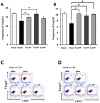Enhanced Anti-Allergic Activity of Milk Casein Phosphopeptide by Additional Phosphorylation in Ovalbumin-Sensitized Mice
- PMID: 30791382
- PMCID: PMC6412743
- DOI: 10.3390/molecules24040738
Enhanced Anti-Allergic Activity of Milk Casein Phosphopeptide by Additional Phosphorylation in Ovalbumin-Sensitized Mice
Abstract
The proteolytic digest of milk casein, known as casein phosphopeptide (CPP-III), exhibits diverse biological activities, including calcium absorption and antioxidant activities. We hypothesized that the additional phosphorylation of this peptide can enhance its immunomodulatory activity such as suppression of allergy-associated cytokine and antigen-specific immune response. This study was conducted to assess whether oral intake of additionally phosphorylated CPP-III (P-CPP) attenuates ovalbumin (OVA)-induced IgE-mediated allergic reactions because of the additional phosphate groups. Female BALB/c mice were intraperitoneally sensitized with OVA twice at intervals of 14 days and then orally fed native CPP-III (N-CPP), P-CPP, and dephosphorylated CPP-III (D-CPP) for 6 weeks. Next, the mice were orally challenged with 50 mg of OVA. Oral administration of P-CPP suppressed total and specific IgE levels in the serum. Mice fed P-CPP exhibited low levels of OVA-specific IgG1 and increased OVA-specific IgG2a. P-CPP also suppressed IL-4 production, while D-CPP showed similar a level compared to that of the control. Further, P-CPP increased the population of the T follicular helper (Tfh) cell in the spleen. These results suggest that additional phosphorylation of CPP can enhance the attenuation of allergen-specific IgE-modulated allergic reactions in a murine food allergy model.
Keywords: anti-allergic activity; immunomodulation; phosphopeptide; phosphorylation.
Conflict of interest statement
The authors declare no conflict of interest.
Figures






Similar articles
-
Role of phosphate groups on antiviral activity of casein phosphopeptide against feline calicivirus as a surrogate for norovirus.J Sci Food Agric. 2017 Apr;97(6):1939-1944. doi: 10.1002/jsfa.7999. Epub 2016 Sep 22. J Sci Food Agric. 2017. PMID: 27545286
-
Influence of bovine and caprine casein phosphopeptides differing in alphas1-casein content in determining the absorption of calcium from bovine and caprine calcium-fortified milks in rats.J Dairy Res. 2007 Aug;74(3):356-66. doi: 10.1017/S0022029907002725. Epub 2007 Jul 26. J Dairy Res. 2007. PMID: 17655779
-
Quillaja saponin can modulate ovalbumin-induced IgE allergic responses through regulation of Th1/Th2 balance in a murine model.J Agric Food Chem. 2006 May 3;54(9):3271-6. doi: 10.1021/jf060169h. J Agric Food Chem. 2006. PMID: 16637684
-
Biopeptides of milk: caseinophosphopeptides and mineral bioavailability.Reprod Nutr Dev. 2004 Sep-Oct;44(5):493-8. doi: 10.1051/rnd:2004053. Reprod Nutr Dev. 2004. PMID: 15636166 Review.
-
Identification, production and bioactivity of casein phosphopeptides - A review.Food Res Int. 2022 Jul;157:111360. doi: 10.1016/j.foodres.2022.111360. Epub 2022 May 20. Food Res Int. 2022. PMID: 35761622 Review.
Cited by
-
Discovery of calcium-binding peptides derived from defatted lemon basil seeds with enhanced calcium uptake in human intestinal epithelial cells, Caco-2.Sci Rep. 2022 Mar 18;12(1):4659. doi: 10.1038/s41598-022-08380-0. Sci Rep. 2022. PMID: 35304505 Free PMC article.
-
A2 adenosine receptor contributes to the development of cow's milk protein allergy via regulating regulatory T cells.Iran J Basic Med Sci. 2021 Oct;24(10):1380-1387. doi: 10.22038/IJBMS.2021.57614.12812. Iran J Basic Med Sci. 2021. PMID: 35096296 Free PMC article.
-
Overview of protein posttranslational modifications in Arthropoda venoms.J Venom Anim Toxins Incl Trop Dis. 2022 Apr 15;28:e20210047. doi: 10.1590/1678-9199-JVATITD-2021-0047. eCollection 2022. J Venom Anim Toxins Incl Trop Dis. 2022. PMID: 35519418 Free PMC article. Review.
References
-
- Théolier J., Fliss I., Jean J., Hammami R. Antimicrobial Peptides of Dairy Proteins: From Fundamental to Applications. Food Rev. Int. 2014;30:134–154. doi: 10.1080/87559129.2014.896017. - DOI
MeSH terms
Substances
LinkOut - more resources
Full Text Sources

